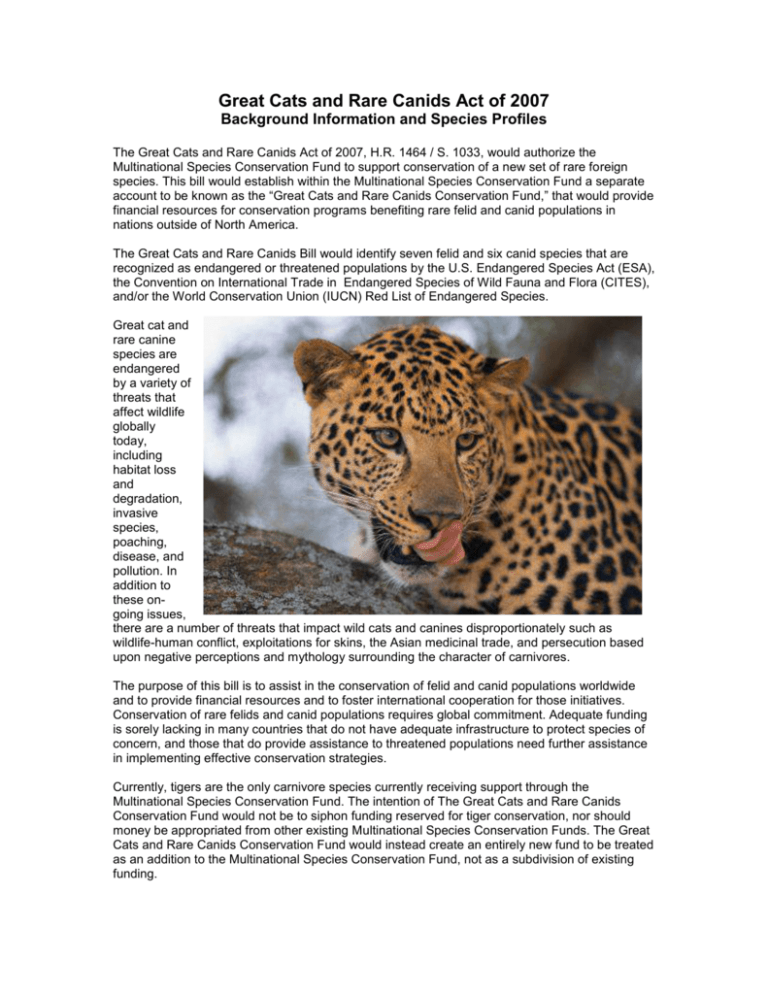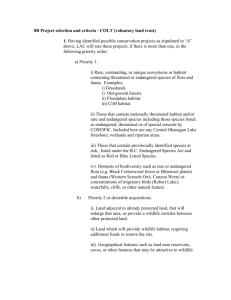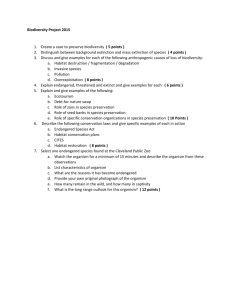Great Cats and Rare Canids Act of 2005
advertisement

Great Cats and Rare Canids Act of 2007 Background Information and Species Profiles The Great Cats and Rare Canids Act of 2007, H.R. 1464 / S. 1033, would authorize the Multinational Species Conservation Fund to support conservation of a new set of rare foreign species. This bill would establish within the Multinational Species Conservation Fund a separate account to be known as the “Great Cats and Rare Canids Conservation Fund,” that would provide financial resources for conservation programs benefiting rare felid and canid populations in nations outside of North America. The Great Cats and Rare Canids Bill would identify seven felid and six canid species that are recognized as endangered or threatened populations by the U.S. Endangered Species Act (ESA), the Convention on International Trade in Endangered Species of Wild Fauna and Flora (CITES), and/or the World Conservation Union (IUCN) Red List of Endangered Species. Great cat and rare canine species are endangered by a variety of threats that affect wildlife globally today, including habitat loss and degradation, invasive species, poaching, disease, and pollution. In addition to these ongoing issues, there are a number of threats that impact wild cats and canines disproportionately such as wildlife-human conflict, exploitations for skins, the Asian medicinal trade, and persecution based upon negative perceptions and mythology surrounding the character of carnivores. The purpose of this bill is to assist in the conservation of felid and canid populations worldwide and to provide financial resources and to foster international cooperation for those initiatives. Conservation of rare felids and canid populations requires global commitment. Adequate funding is sorely lacking in many countries that do not have adequate infrastructure to protect species of concern, and those that do provide assistance to threatened populations need further assistance in implementing effective conservation strategies. Currently, tigers are the only carnivore species currently receiving support through the Multinational Species Conservation Fund. The intention of The Great Cats and Rare Canids Conservation Fund would not be to siphon funding reserved for tiger conservation, nor should money be appropriated from other existing Multinational Species Conservation Funds. The Great Cats and Rare Canids Conservation Fund would instead create an entirely new fund to be treated as an addition to the Multinational Species Conservation Fund, not as a subdivision of existing funding. The Great Cats and Rare Canids Act of 2007 Species Profiles Cheetah (Acinonyx jubatus) Cheetahs are distributed primarily throughout the drier parts of sub-Saharan Africa as well as in Iran. The principle threat to cheetahs has long been recognized to be a very high level of homogeneity in coding DNA, which may render the cheetah an exceptionally vulnerable species. The cheetah is also vulnerable to competition with other large carnivores for habitat and prey. Survival is also affected by conflicts with people over predation on livestock. Clouded Leopard (Neofelis nebulosa) The clouded leopard is found in the forests of Asia. Deforestation and habitat fragmentation are the foremost threats. Secondly, the clouded leopard is widely hunted for its teeth and decorative pelt, and for bones for the traditional Asian medicinal trade. Iberian Lynx (Lynx pardina) The Iberian lynx is considered the most endangered cat species in the world due to its low total numbers, the fragmentation and the availability of habitat, and small geographic range limited to Spain and Portugal. Population decline has been due to the spread of a disease which decimated populations of the European rabbit, the lynx's main prey. Additional factors in the lynx's decline include illegal hunting, accidental killing by snares and poison baits, and road kill. Jaguar (Panthera onca) Jaguars are distributed in regions throughout Central and South America, with key populations in the Yucatan peninsula as well as the Pantanal of Brazil, Bolivia and Paraguay. Principal threats include deforestation rates and fragmentation of forest habitat, as well as local extirpation at the hands of cattle ranchers. Leopard (Panthera pardus) The leopard’s range is widespread, ranging throughout the Africa, the Middle East, India, and into southeast Asia. The leopard appears to be very successful at adapting to altered natural habitat and settled environments in the absence of intense persecution. Although the leopard populations are not endangered throughout this entire range, many threats affect the future of these populations including exploitation, population fragmentation, and loss of habitat. Lion (Panthera leo) East and Southern Africa are home to the majority of the African lion population, with a second isolated population of lions residing in the Gir forest of India. Lions are generally considered serious problem animals whose existence is at odds with human settlement and cattle culture. Their scavenging behavior makes them particularly vulnerable to poisoned carcasses put out to eliminate predators. Each year people are killed by lions, and the level of human-predator conflict is high. Snow Leopard (Uncia uncia) The snow leopard has an extremely patchy and fragmented distribution, consisting of a mix of mountain systems throughout a vast region in Tibet and other parts of China. Threats to this population include habitat fragmentation, diminished prey base, hunting and poisoning programs intended for other animals, as well as conflict with local villages due to livestock depredation. There is demand for snow leopard bones for use in the Chinese medicinal trade, and there is still some demand for snow leopard fur on the black market. African Wild Dog (Lycaon pictus) The African Wild Dog is one of the Africa’s most endangered animals. It is believed that fewer than 5,000 wild dogs currently exist in the wild, and their range has declined significantly. The effects of diseases spread by domestic dogs have had a devastating effect on wild dog numbers. Habitat fragmentation has lead to the isolation of populations which has lead to inbreeding and associated problems. Bush Dog (Speothos venaticus) Rare throughout its entire range in the jungles of South America, the bush dog is the most social of the small canids, living in groups of up to 10 individuals. Populations of bush dogs continue to decline as their natural habitat is converted to human use for farming and other development. Dhole (Cuon alpinus) The dhole is a rare species of wild dog native to southern Asia. Unlike other endangered canids, the dhole is not widely recognized and has received very little attention, even though its population is threatened with extinction. The major threats to the dhole are habitat destruction, loss off a prey base, human persecution, disease and inbreeding. Ethiopian Wolf (Canis simensis) The Ethiopian wolf population is critically endangered throughout its range, with a global population estimated at 400 adults confined to five isolated pockets in Ethiopia. The Ethiopian wolf is a very localized endemic species, and very sensitive to pressures such as inbreeding, disease, hunting, and habitat loss. Maned Wolf (Chrysocyon brachyurus) A native resident of the grasslands regions of South America, the maned wolf is endangered throughout its home range. The maned wolf’s survival in the wild is threatened by a number of factors, including hunting, conflict with ranchers, and habitat loss. There is also a demand for several parts of the wolf’s anatomy, which are used for traditional medicinal remedies. Gray Wolf (Canis lupus) The gray wolf occupies a large geographic range in Europe, Middle East and Asia. Threats include competition with humans for livestock, misunderstanding on the part of the public concerning the threat and danger of wolves, clearance and fragmentation of habitat, and hybridization with domestic and feral dogs.





